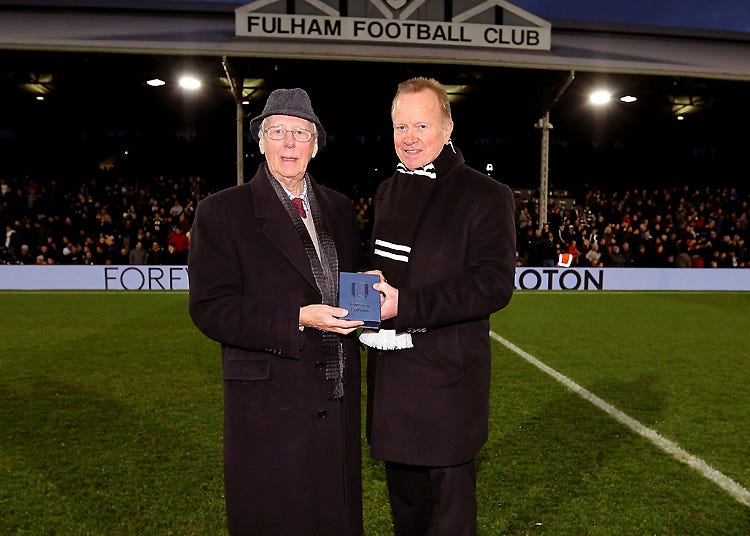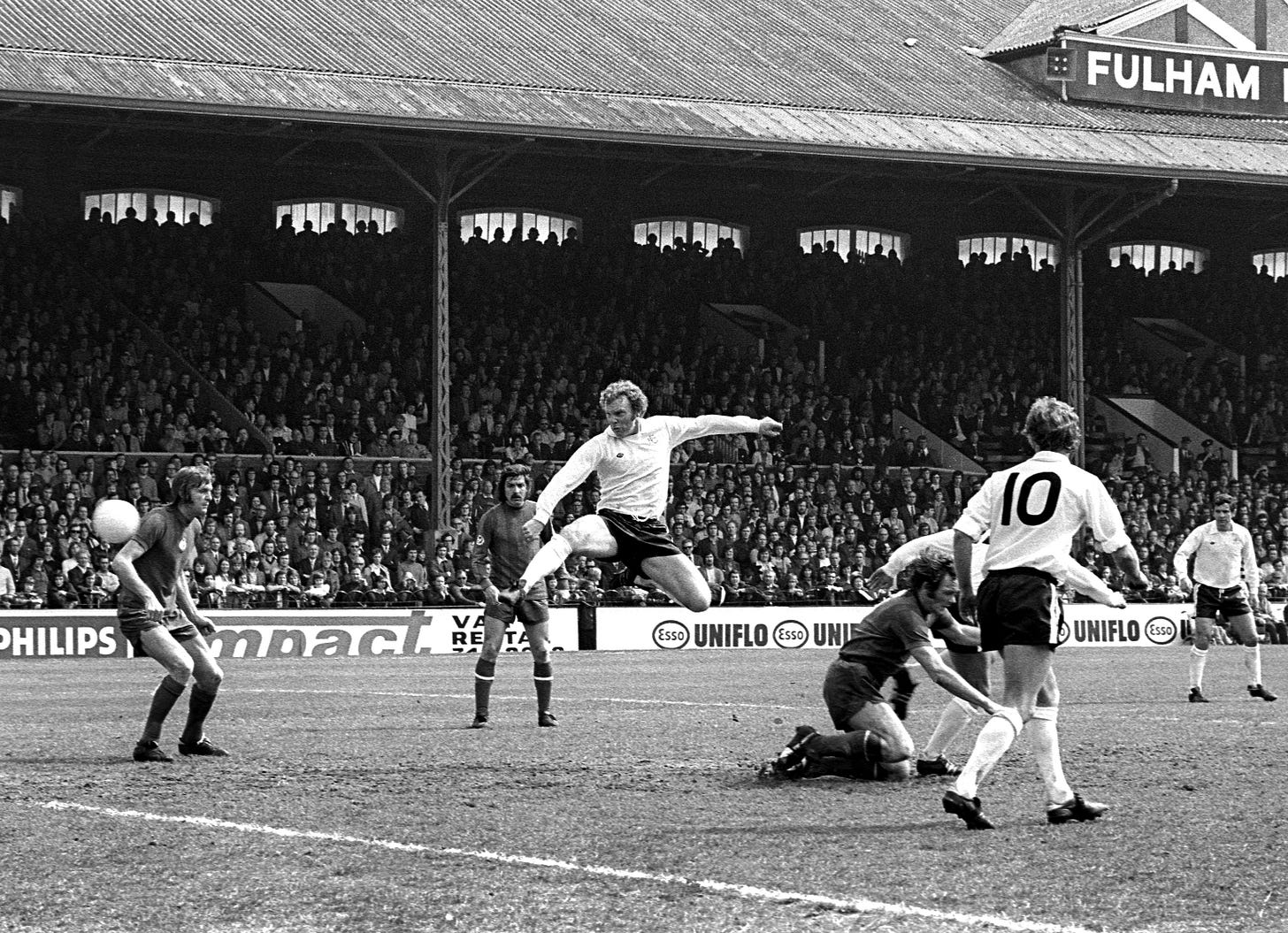How Ken Coton built a legacy behind the lens at Craven Cottage
Drew Heatley continues his journey of speaking to the men and women who helped shaped Fulham FC.
They say a picture is worth 1,000 words - in which case, Ken Coton has created dozens of Fulham FC anthologies.
“I’ve been very lucky”, Ken - in his typically humble manner - tells me.
Coton enjoyed a more-than 40-year relationship with Fulham as the club’s matchday photographer. And it all started with the Maestro himself.
“I tended to sneak my camera in and take a few pictures as a fan,” he recalls. “I did some prints and showed them to my dad. He worked with a chap who knew Johnny Haynes. Somehow the pictures got back to him and it just developed from there. Johnny said, ‘Well, Ken, come on the pitch and take a picture of me’.”
That iconic pitch-side portrait blossomed into a fruitful relationship - but whether or not there was a label placed on it remains to be seen.
“I don’t know whether I was ‘officially’ official photographer, I really can’t remember. But I was delighted to do it!
“I started supplying a picture for the programme every week in those days when there was just one picture in the programme. Then in 1965 or ‘66 they decided to revamp it. A chap called Peter Moss, who used to work for the Daily Mail, came along. He was an editorial chap and he knew about things. They got me involved more and more, taking lots of pictures, and eventually I had my own pages.”
Those pages would have been packed in 1975 as the Whites went all the way to Wembley in the FA Cup, with Ken pitch-side - and eventually on the team coach.
“I was at the hotel to take pictures the players there and then get to Wembley,” he recalls. “And I said to Alex Stock, ‘Any chance of getting on the coach to go to Wembley?’, because otherwise I’d have to get a taxi. He said, ‘No, I don’t really think so’. Then he came back later and said, ‘OK - you’re on!’. And so I was on the coach to Wembley. I went into the dressing room before the match and was on the pitch. That was quite a highlight, I must say!”
It understandably ranks high among the decades of memories - alongside our 1996/97 promotion season under Micky Adams (“It all got rather exciting, didn’t it?”). But there’s an on-pitch memory without a camera that Coton also cherishes.
“I got a Forever Fulham award - aren’t I lucky? I was the first non-footballer to get it.”
And rightly so. FFC Director David Daly told me that the award was initially created for players who made more than 100 appearances - Ken, of course, racked up significantly more on the touchline and behind the goal in his spectacles and iconic hat.
“That’s true,” Ken concedes. “Sitting in the cold and the rain. I never complained. I remember I used to get frozen fingers at times. I thought, ‘How can I wind on the camera and press the button?”
Speaking of wind-up cameras, I wondered what being a matchday snapper was like in the days before digital SLRs and instant uploads.
“Sometimes fans would come out of the ground at the end of the match and say ‘Ken, did you get the goal?’ And of course the answer was always: ‘I don’t know!” he laughs. “‘I’ll tell you in a day when I’ve been home, processed the film and looked up at them to see if there’s a goal on there’. Luckily I didn’t do too badly and I got quite a few!”
Ken captured more than a few iconic shots. But what were his favourites?
“I love my picture of Bobby Moore scoring his only goal for Fulham. It was against Crystal Palace. I think we lost, but he scored and it was his only goal. And Johnny Haynes’s last goal at home.”
With so many games committed to film, it must be difficult to remember them all, with only the sublime - and ridiculous - standing out.
“We played Crystal Palace in 1978”, Ken remembers. “The match ended, and I used to get out quickly, so I went to my car, sat and poured a cup of tea. I turned on the wireless and the presenter said, ‘Here are the football results: Crystal Palace versus Fulham - result not yet in’. And I thought, ‘But I’ve just been there!’.
“What had happened was that the referee had blown five minutes too early! The players were in the bath already, and apparently the referee went in and said, ‘I’m sorry, you’ve got to come out and play another five minutes’. There was an incident or something I missed, so in the following programme I put in a picture with nothing on it, saying this was the incident I missed!”
Ken continued snapping away at Craven Cottage - and across the country - recording the Whites through mostly dark days, until Micky Adams started our charge up the league table. And when we reached the promised land, it was time to hang up the SLR.
“We finally got to the Premiership in 2001. And I, suddenly realised ‘This is too big a job for one person’. Because it was really, wasn’t it? Fulham then needed pictures of everything. We amicably parted company, and I was given a pass to go to matches - for a couple of seasons at least.”
It’s fascinating to think that the lion’s share of Fulham’s history for 40+ years was recorded by one man, when today you have at least 20 photographers in hi-vis vests recording every millisecond of a game and uploading it instantly to Getty, Shutterstock, or some other organisation.
Today, Fulham has a pool of matchday photographers to draw on. One of them, Fulham fan Javier Garcia, Ken knows from many moons ago.
“I think we were somewhere like Reading, probably in the 90s or something. And this photographer sidled up to me - it was Javier. He said I was the one who inspired him to become a photographer and take football pictures. How exciting, eh?”
It’s an illustration of the legacy Ken built at Fulham. Not only capturing the highs and the lows of this special club, but inspiring others to carry that mission on.

So much of Ken’s knowledge, passion and work can be found in an extensive series of books released through his Ashwater Press publishing house, which he runs with fellow Fulham fan and walking FFC encyclopedia, Martin Plumb.
“It first started with (former Fulham board member and official historian) Dennis Turner,” Ken recalls. “He wanted to do a book of Fulham years. And of course, I’d always wanted to do a book of Fulham pictures, but had no facilities or way of doing things - and no money. And somehow, we got together and created Fulham’s Golden Years, which was the first Ashwater book.
“It’s amazing how many we’ve done when you think about it. I was on Putney Station once, and this chap came out to me and said, ‘I’ve written this book about Fulham in 1968. Are you interested in it?’ That was Martin Plumb. We’re still friends now and we have done most of the books together. Martin is full of facts and remembers everything. You could ask about the time Fulham played Leyton Orient in 1973 and he could tell you the score and even the Orient team!”
As Ken looks back on a career that meant so much to so many, how does he see it?
“I always say I had the best seat in the house. I was privileged to do it.
“It’s funny; people say to me, ‘I grew up with you and I used to get the programme and look at the pictures’. And I think, ‘well, isn’t that lovely?’ It was a pleasure to do that.”
I think it’s safe to say the pleasure was all ours.








As an overseas supporter with no resources for FFC history or insights, I appreciate these type of stories. Well written mate.
This is a really beautiful piece, Drew. I’ve been supporting Fulham for nearly 60 years now, and this brought tears to my eyes. Thanks so much for doing it.